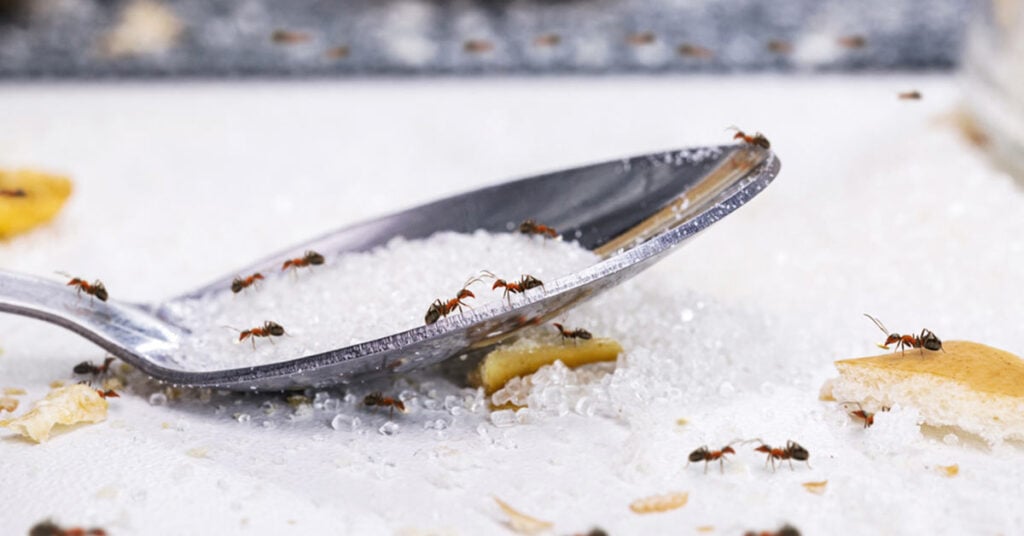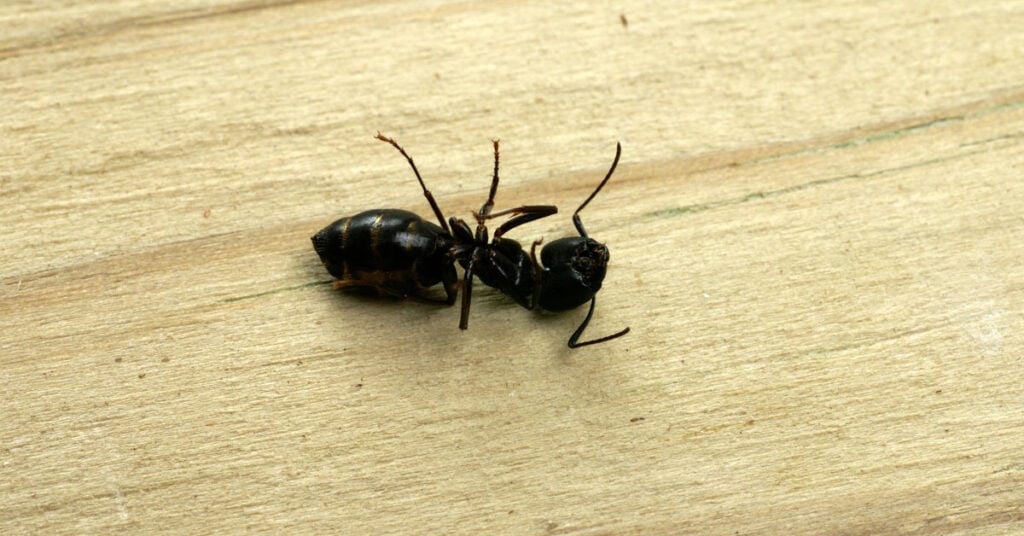From the tenacious carpenter ants that can undermine the integrity of wooden structures to the tiny yet relentless pavement ants that invade our homes, understanding the distinctions between ant types is crucial in formulating targeted treatment strategies. By exploring the physical features, nesting habits, and typical behaviors of common ant species such as black ants, fire ants, sugar ants, army ants, and more, we can better tailor our pest control approaches to address specific ant problems.

Black ants
Black ants are a commonly encountered ant species in North America. They are small in size and typically black or dark brown in color. These ants have a segmented body with a distinct head, thorax, and abdomen. Black ants can vary in size, but most are around 1/8 to 1/4 inch in length.
Physical Features of Black Ants
Black ants have a well-defined waist (narrow connection between the thorax and abdomen) and six legs. They have antennae, which they use for sensing their environment. The workers have a glossy appearance, while the reproductive ants (males and females) may have wings during certain times of the year.
How to Differentiate Black Ants From Other Species Like Pavement and Carpenter Ants
Distinguishing black ants from other ant species like pavement ants and carpenter ants can be challenging. However, black ants tend to be smaller in size compared to carpenter ants, which can grow up to half an inch in length. Additionally, black ants do not have the same destructive tendencies as carpenter ants, which excavate wood to build their nests. Pavement ants, on the other hand, have a distinct uneven thorax with parallel grooves.
Carpenter ants
Carpenter ants are larger ants commonly found in North America. They can range in size from 1/4 to 1/2 inch in length. Carpenter ants vary in color, with black, reddish, or a combination of black and red being the most common.
Characteristics of Carpenter Ants
Carpenter ants have a robust body structure, with a large head and strong jaws. They are known for their ability to excavate wood and create elaborate nesting galleries. Carpenter ants do not eat wood but instead tunnel through it, causing potential damage to wooden structures in homes.
Nesting Habits of Carpenter Ants
Carpenter ants establish their nests in moist or decaying wood, which can include tree stumps, firewood piles, and even structural components of buildings. They create galleries and chambers within the wood, where they live and raise their broods. Carpenter ants also have satellite nests, which can make finding and eliminating them more challenging.
Are Carpenter Ants More Destructive Than Other Ant Species?
Carpenter ants are known for their ability to tunnel through wood, but they do not consume wood for sustenance like termites. While carpenter ants can cause structural damage over time, they are not typically as destructive as termites.
How to Tell the Difference Between Black Ants and Carpenter Ants
Distinguishing between black ants and carpenter ants can be challenging. However, carpenter ants are larger than many other ant species and can range in size from 1/4 to 1/2 inch. Unlike black ants, carpenter ants have a robust body structure, large heads, and strong jaws. Additionally, carpenter ants are often found near moist or decaying wood, as they use it for nesting.
-
Best OverallSave $50 on your first recurring service today with code GET50
-
Best for TermitesSave $50 on pest control services with code SAVE50 at checkout
-
Best for Bed BugsGet a free estimate on pest control services for your home
-
Best for Wildlife RemovalCall For A Fast & FREE Phone Estimate Today
-
Best for Natural TreatmentGet $100 Off Your Termite Treatment Service
Fire ants
Fire ants are reddish-brown ants known for their aggressive behavior and painful stings. They are most commonly found in the southern regions of the United States. Fire ants construct large, visible mounds and are known for their defensive behavior when their nests are disturbed.
How Fire Ants Differ From Other Types of Ants
Fire ants are distinct from other ant species due to their aggressive behavior and painful sting. Unlike many ants that bite, fire ants have a unique stinger that injects venom, causing a burning sensation and the formation of pustules or blisters on the skin. Their reddish-brown coloration and aggressive defense of their nests make them easily recognizable.
The Preferred Habitats of Fire Ants
Fire ants thrive in warm climates, primarily in the southern regions of the United States. They construct large, visible mounds in open areas such as lawns, parks, and agricultural fields. Fire ants are adaptable and can colonize a variety of habitats, including urban and rural environments.
Lifespan of Fire Ants
The lifespan of a fire ant colony can vary, but individual worker ants typically live for several months. Queen fire ants can live for several years, and they are responsible for reproduction and the establishment of new colonies.
How to Prevent a Fire Ant Infestation in Your Yard
Preventing fire ant infestations involves maintaining a clean and tidy yard. Clearing debris, keeping vegetation trimmed, and regularly inspecting and treating mounds can help discourage fire ants from establishing colonies. Treating outdoor areas with appropriate insecticides can also be an effective preventive measure.
Sugar ants
The term “sugar ants” is often used to refer to various species of ants that are attracted to sugary substances. These ants are typically small in size and range in color from light brown to black. They can be found throughout North America and are commonly encountered in kitchens and areas where food is present.
Are Sugar Ants and Pavement Ants the Same Thing?
The term “sugar ants” is often used interchangeably with pavement ants, but it can also refer to various species of ants that are attracted to sugary substances. Therefore, sugar ants can encompass different ant species, including pavement ants.
What do Sugar Ants Feed On?
Sugar ants have a preference for sugary substances, such as nectar, honeydew produced by aphids, and food residues containing sugars. They are attracted to sweet foods and can be commonly found foraging in kitchens and areas where food is prepared or stored.
Are Sugar Ants Attracted to Sweet or Sugary Foods?
Yes, sugar ants are particularly attracted to sweet or sugary foods. Their foraging trails can be seen leading to sugary food sources, making them a common nuisance in households.
How do Sugar Ants Communicate With Each Other?
Sugar ants use chemical signals called pheromones to communicate with each other. These pheromones help them navigate, establish foraging trails, and communicate information about food sources to other members of the colony.
Army Ants
Army ants are nomadic ants that do not build permanent nests. Instead, they travel in large groups or “armies” in search of food. They are more commonly found in tropical regions but may occasionally be encountered in North America.
What do Army Ants Feed on?
Army ants primarily feed on other small invertebrates such as insects, spiders, and other arthropods. They are voracious predators and move in large swarms, hunting and devouring any small creatures they encounter in their path. Their diet also includes small reptiles, amphibians, and bird eggs, making them versatile hunters in their ecosystem. Army ants have sharp mandibles that enable them to tear apart their prey, and they communicate and coordinate their movements using pheromones.
Lifespan of Army Ants
The lifespan of army ants varies depending on the species. Generally, the worker ants have a lifespan of a few weeks to several months, while the queen can live for several years. The queen is responsible for reproducing and producing new offspring, while the worker ants are responsible for foraging, building and maintaining the nest, and protecting the colony.
Do Army Ants Cause Health Risks?
Army ants, like other ants, are not known to directly pose significant health risks to humans. They do not typically bite or sting unless provoked, and their bites are not typically harmful unless an individual has an allergic reaction. However, if an army ant colony invades a human living space, they can cause discomfort and stress due to their sheer numbers and their ability to quickly overrun an area. In some cases, people may experience skin irritation or allergic reactions if bitten by army ants, but such incidents are relatively rare.
Can Army Ants Cause Structural Damage to My House or Garden?
While army ants do not typically cause structural damage to houses or gardens, they can be a nuisance if they establish a nest nearby. They are highly mobile and can create temporary nests in various locations as they continue their relentless search for prey. If an army ant colony locates a food source near a house or garden, they may travel through these areas in large numbers, causing a disturbance. However, they do not chew through structures or cause direct physical damage like termites or carpenter ants.
How to Identify Army Ants and Distinguish Them From Other Species
Army ants are known for their nomadic behavior and large swarms that move together in search of food. They have powerful mandibles and are typically larger in size compared to many other ant species. Their behavior and distinctive appearance.
Pavement Ants
Pavement ants are small, dark-colored ants that often create nests under pavement or in cracks in sidewalks, driveways, and foundations. They are commonly found throughout North America and are known for their affinity for nesting near human structures.
What do Pavement Ants Feed on?
Pavement ants, also known as Tetramorium caespitum, are opportunistic omnivores. They have a diverse diet that includes both plant and animal matter. Their primary food sources consist of sugary substances, such as nectar, honeydew produced by aphids, and various sweet food scraps. Additionally, they scavenge for protein-rich foods like dead insects, seeds, and crumbs left by humans. Pavement ants are known to be attracted to sugary foods, making them common visitors to kitchens and food storage areas.
Lifespan of Pavement Ants
The lifespan of pavement ants varies depending on various factors such as environmental conditions and the presence of predators. The worker ants typically live for a few months, while the queens can live for several years. Pavement ant colonies consist of multiple queens, each capable of reproducing and establishing satellite colonies. The worker ants are responsible for foraging, nest maintenance, and caring for the brood.
Do Pavement Ants Cause Health Risks?
Pavement ants, in general, do not pose significant health risks to humans. They are not known to carry or transmit diseases directly. However, like other ants, they can contaminate food if they come into contact with it, potentially leading to foodborne illnesses. Moreover, their presence indoors can be a nuisance and cause stress for homeowners. In rare cases, people may experience mild allergic reactions or skin irritation if bitten by pavement ants.
Can Pavement Ants Cause Structural Damage to My House or Garden?
Pavement ants are not typically associated with causing structural damage to houses or gardens. They do not have the ability to chew through materials like termites. However, they can create small nests in soil or cracks in pavement near buildings, and their foraging activities may lead them indoors. While they do not directly damage structures, their nesting behavior can be an annoyance, particularly if they establish colonies inside walls or foundations. It’s important to address any potential entry points and eliminate food sources to discourage pavement ants from entering the house.
-
Best OverallSave $50 on your first recurring service today with code GET50
-
Best for TermitesSave $50 on pest control services with code SAVE50 at checkout
-
Best for Bed BugsGet a free estimate on pest control services for your home
-
Best for Wildlife RemovalCall For A Fast & FREE Phone Estimate Today
-
Best for Natural TreatmentGet $100 Off Your Termite Treatment Service
Common Misconceptions and Confusions: Ants vs. Termites
Can Termites Be Mistaken For Ants?
Yes, termites can be mistaken for ants due to some similarities in their appearance and behavior. Both insects have segmented bodies with heads, thoraxes, and abdomens. They also live in colonies and can cause damage to wooden structures. The confusion arises because both ants and termites have reproductive individuals with wings that are often seen during swarming periods. However, it is important to note that termites are not ants and belong to a separate insect order called Isoptera.
How do Termites Differ From Ants in Terms of Appearance?
Termites and ants have several distinguishing features that can help in telling them apart. Termites generally have straight, beaded antennae, while ants have elbowed or bent antennae. Termites have a uniform width throughout their bodies, whereas ants have a constricted waist. Additionally, termite wings are of equal length and are typically longer than their bodies, while ants have wings of different lengths, with the front pair longer than the hind pair.
Are Termites More Destructive Than Carpenter Ants?
Termites are often considered more destructive than carpenter ants when it comes to damaging wooden structures. While carpenter ants excavate wood to create nests, they do not consume the wood as a food source. In contrast, termites feed on cellulose present in wood, causing severe damage over time. Termites have specialized gut bacteria that help them break down cellulose, making them highly efficient at utilizing wood as a food source. If left untreated, termite infestations can lead to significant structural damage and costly repairs. It is crucial to address termite infestations promptly and seek professional assistance for effective control and prevention measures.
Conclusion
Understanding the importance of different ant species is crucial in managing and preventing infestations. While some ants may cause structural damage like carpenter ants, others like fire ants can be aggressive and pose potential health risks. Recognizing the differences between ants and termites is also essential to avoid confusion and take appropriate action when dealing with these pests. Implementing effective control methods when necessary, such as maintaining cleanliness, sealing entry points, and seeking professional help if infestations become difficult to manage.









